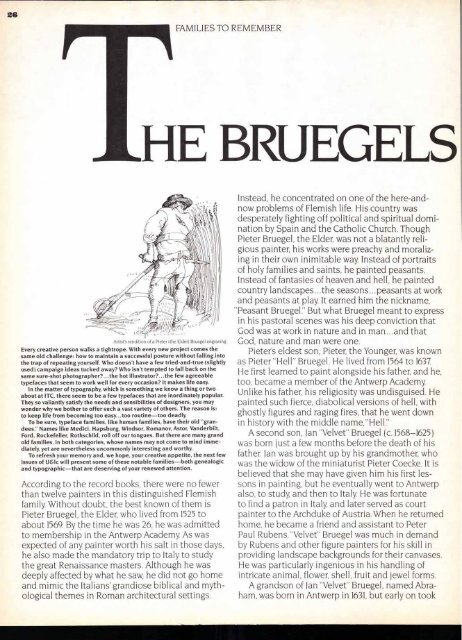Volume 12–4 (Low Res).pdf - U&lc
Volume 12–4 (Low Res).pdf - U&lc
Volume 12–4 (Low Res).pdf - U&lc
You also want an ePaper? Increase the reach of your titles
YUMPU automatically turns print PDFs into web optimized ePapers that Google loves.
26<br />
FAMILIES TO REMEMBER<br />
HE BRUEGELS<br />
Artist's rendition of a Pieter (the Elder) Bruegel engraving .<br />
Every creative person walks a tightrope. With every new project comes the<br />
same old challenge: how to maintain a successful posture without falling into<br />
the trap of repeating yourself. Who doesn't have a few tried-and-true (slightly<br />
used) campaign ideas tucked away? Who isn't tempted to fall back on the<br />
same sure-shot photographer?...the hot illustrator?...the few agreeable<br />
typefaces that seem to work well for every occasion? It makes life easy.<br />
In the matter of typography, which is something we know a thing or two<br />
about at ITC, there seem to be a few typefaces that are inordinately popular.<br />
They so valiantly satisfy the needs and sensibilities of designers, you may<br />
wonder why we bother to offer such a vast variety of others. The reason is:<br />
to keep life from becoming too easy...too routine—too deadly.<br />
To be sure, typeface families, like human families, have their old "grandees."<br />
Names like Medici, Hapsburg, Windsor, Romanov, Astor, Vanderbilt,<br />
Ford, Rockefeller, Rothschild, roll off our tongues. But there are many grand<br />
old families, in both categories, whose names may not come to mind immediately,<br />
yet are nevertheless uncommonly interesting and worthy.<br />
To refresh your memory and, we hope, your creative appetite, the next few<br />
issues of U&Ic will present some of these notable families—both genealogic<br />
and typographic—that are deserving of your renewed attention.<br />
According to the record books, there were no fewer<br />
than twelve painters in this distinguished Flemish<br />
family. Without doubt, the best known of them is<br />
Pieter Bruegel, the Elder, who lived from 1525 to<br />
about 1569. By the time he was 26, he was admitted<br />
to membership in the Antwerp Academy. As was<br />
expected of any painter worth his salt in those days,<br />
he also made the mandatory trip to Italy to study<br />
the great Renaissance masters. Although he was<br />
deeply affected by what he saw, he did not go home<br />
and mimic the Italians' grandiose biblical and mythological<br />
themes in Roman architectural settings.<br />
Instead, he concentrated on one of the here-andnow<br />
problems of Flemish life. His country was<br />
desperately fighting off political and spiritual domination<br />
by Spain and the Catholic Church. Though<br />
Pieter Bruegel, the Elder, was not a blatantly religious<br />
painter, his works were preachy and moralizing<br />
in their own inimitable way. Instead of portraits<br />
of holy families and saints, he painted peasants.<br />
Instead of fantasies of heaven and hell, he painted<br />
country landscapes...the seasons...peasants at work<br />
and peasants at play. It earned him the nickname,<br />
"Peasant Bruegel." But what Bruegel meant to express<br />
in his pastoral scenes was his deep conviction that<br />
God was at work in nature and in man...and that<br />
God, nature and man were one.<br />
Pieter's eldest son, Pieter, the Younger, was known<br />
as Pieter "Hell" Bruegel. He lived from 1564 to 1637.<br />
He first learned to paint alongside his father, and he,<br />
too, became a member of the Antwerp Academy.<br />
Unlike his father, his religiosity was undisguised. He<br />
painted such fierce, diabolical versions of hell, with<br />
ghostly figures and raging fires, that he went down<br />
in history with the middle name,"Hell."<br />
A second son, Jan "Velvet" Bruegel (c.1568-1625)<br />
was born just a few months before the death of his<br />
father. Jan was brought up by his grandmother, who<br />
was the widow of the miniaturist Pieter Coecke. It is<br />
believed that she may have given him his first lessons<br />
in painting, but he eventually went to Antwerp<br />
also, to study, and then to Italy. He was fortunate<br />
to find a patron in Italy, and later served as court<br />
painter to the Archduke of Austria. When he returned<br />
home, he became a friend and assistant to Peter<br />
Paul Rubens. "Velvet" Bruegel was much in demand<br />
by Rubens and other figure painters for his skill in<br />
providing landscape backgrounds for their canvases.<br />
He was particularly ingenious in his handling of<br />
intricate animal, flower, shell, fruit and jewel forms.<br />
A grandson of Jan "Velvet" Bruegel, named Abraham,<br />
was born in Antwerp in 1631, but early on took
















